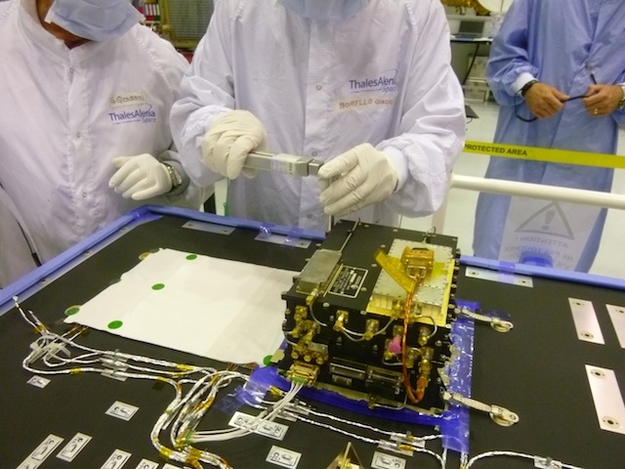The ExoMars Trace Gas Orbiter (TGO) carries two Electra radios provided by NASA, which were installed at Thales Alenia Space, in Cannes, France, in June 2014, when the spacecraft was being built.

ESA’s ExoMars Trace Gas Orbiter (TGO) carries two Electra radios provided by NASA. This image shows a step in installation and testing of the first of the two radios, inside a clean room at Thales Alenia Space, in Cannes, France, in June 2014. Credit: NASA/JPL-Caltech/ESA/TAS
These radios will enable TGO to provide communications support for robotic missions on the surface of Mars. Relay of information from Mars-surface craft to Mars orbiters, then from Mars orbit to Earth, enables receiving much more data from the surface missions than would otherwise be possible.
The Electra radios – from NASA’s Jet Propulsion Laboratory, Pasadena, California – include special features for relay use between an orbiter and a rover or stationary lander. For example, it can actively adjust the data rate (‘Adaptive Data Rate’) during a communication session – slower when the orbiter is near the horizon from the surface robot’s perspective, faster when it is overhead. NASA’s Curiosity Mars rover and Mars Reconnaissance Orbiter already use Electra technology for routine relay of data. NASA’s Mars Atmosphere and Volatile Evolution (MAVEN) orbiter also carries an Electra radio.
ESA’s Olivier Reboud, responsible for relay operations on the TGO team, provided an update this week on what’s been happening with respect to rely activities.
Relay update
The first in-flight data-relay tests (a return link at fixed data rates with two rovers – MSL Curiosity and then Opportunity) were conducted on 22 November 2016 when TGO was still on its capture orbit; these were successful.
Since then, we have kept an eye out for an opportunity to test, on the return link, the Adaptative Data Rate (ADR) functionality with MSL Curiosity, potentially during the first half of March – before TGO starts ‘aerobraking’, expected to begin around 15 March (see Skimming an alien atmosphere). This would allow maximising the return link efficiency, but the geometry (TGO elevation and TGO-MSL distance when in visibility), is unfavourable for this test during the first two weeks in March, which iss our final relay test option for TGO before starting aerobraking. As a result, an ADR test will have to wait for a future opportunity.
In fact, this test may have to wait until the end of TGO aerobraking in the first half of 2018. During the aerobraking phase – which will be extended by the Mars-Sun-Earth solar conjunction in July-August 2017 – no relay test activity with any of the rovers is, as of today, foreseen.
Once aerobraking is complete and the main science phase can start, there will be several relay tests to carry out, each to be defined with JPL (like the ADR mentioned above). Another important functional test will be testing the delivery of files (uploaded onboard TGO from Earth) to both rovers via a forward proximity link.
As of now, the on-going relay activities include:
- Preparation of the ground systems and interfaces to be ready at the end of aerobraking for starting operational TGO science and relay planning, execution, and reporting
- Preparation of future relay activities such as ‘back-to-back’ consecutive relay sessions with assets co-located at the same site, e.g. the future ESA Rover and its surface platform
We are also preparing sequences that would allow, if requested by JPL, updating the Electra radio software.
For the time being, the main priority is to safely go through and complete TGO aerobraking.

Discussion: no comments